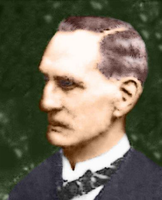










Joseph Day (1855 in London – 1946) is a little-known English engineer who developed the extremely widely used crankcase-compression two-stroke petrol engine,as used for small engines from lawnmowers to mopeds and small motorcycles. He trained as an engineer at the Crystal Palace School of Engineering at Crystal Palace in London, began work at Stothert & Pitt in Bath, and in 1889 designed the crankcase-compression two-stroke engine as it is widely known today (in contrast to the two-stroke engine designed by Dugald Clark), the Valve-less Two-Stroke Engine. In 1878 he started his own business, an iron foundry making cranes, mortar mills and compressors amongst other things.
He advertised a new design of “valveless air compressor” which he made on licence from the patentee, Edmund Edwards. By 1889, he was working on an engine design which would not infringe the patents that Otto had on the four-stroke,and that he eventually called the Valveless Two-Stroke Engine. In fact there were two flap valves in Joseph Day’s original design, one in the inlet port, where you would probably find a reed valve on a modern two stroke, and one in the crown of the piston, because he did not come up with the idea of the transfer ports until a couple of years later. He made about 250 of these first two-port motors, fitting them to small generating sets, which won a prize at the International Electrical Exhibition in 1892.
It was one of Joseph Day’s workmen, Frederick Cock, who made the modification which allowed the skirt of the piston to control the inlet port and do away with valves altogether, giving rise to the classic piston ported two stroke. Only two of these original engines have survived, one in the Deutsches Museum in Munich,the other in the Science Museum in London.
His death in 1946. His obscurity was so complete that a mere five years after his death, the Science Museum made a public appeal for biographical information about him – with no apparent result.